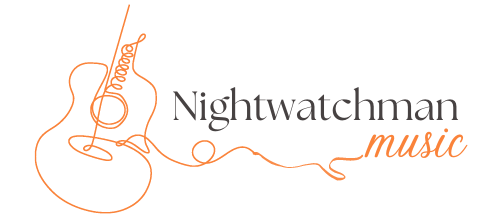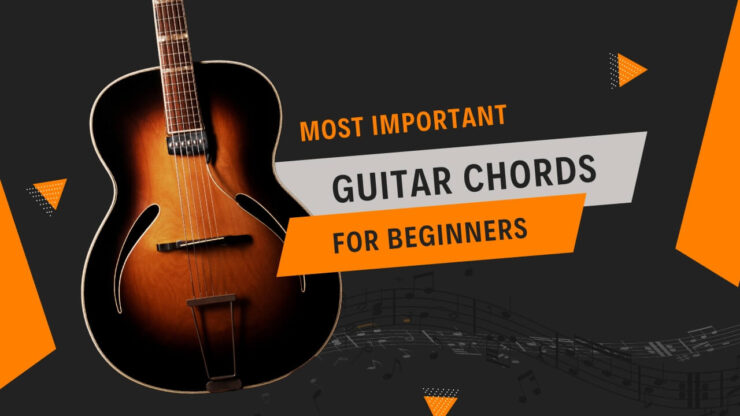Learning to play guitar can be a rewarding and fulfilling experience, but it can also be overwhelming for beginners who are just starting out. One of the most important aspects of learning guitar is mastering basic chords, which are the foundation of playing songs and developing playing technique.
In this article, we will cover some essential guitar chords for beginners, providing detailed instructions on how to play each chord and tips for transitioning between chords smoothly. By mastering these chords, beginners will have the tools they need to play countless songs and progress in their guitar playing journey.
So, let’s get started and dive into the world of guitar chords!
NO SHORTCUTS! We believe if it’s worth learning, it’s worth learning properly. There’s no point in wasting your time with ‘easy versions’ or ‘cheat’ chords. Learn the correct way. Learn once. Sound epic.
Basic Guitar Chords for Beginners
String theory must be mastered prior to learning guitar chords. You’ll be able to understand the chords we’ll be talking about later after you comprehend the harmonic relationship between a guitar’s strings.
Here’s a quick rundown:
- 6th string is the low E
- 5th string is A
- 4th string is D
- 3rd string is G
- 2nd string is B
- 1st string is the high E
The 6th/low E is the top string.
The 1st/high E is located at the bottom of the guitar. If your strings are producing different notes you may have to tune them! Now, what are the first chords to learn on guitar?
1. G Major
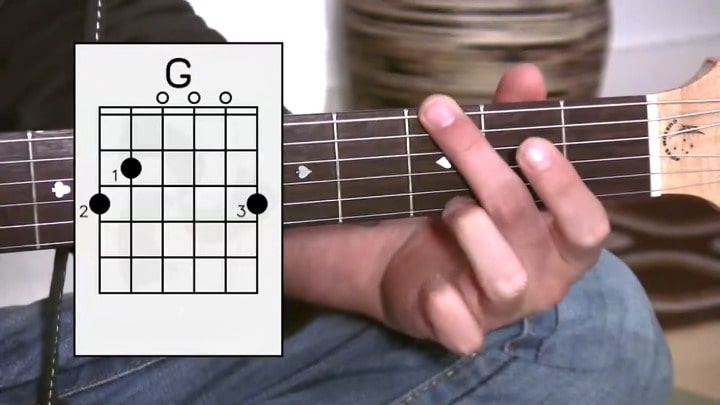
G, B, and D are three-finger notes in G Major. G is the root note, in case you forgot.
- Put your index finger first on the second fret of the fifth string.
- Then, put your middle finger on the sixth string’s third fret.
- Last but not least, place your ring finger on the first string’s third fret.
- Strumming each string with your fingertips firmly down will not muffle the open notes.
G Major is one of the well-known basic guitar chords because each string is strummed. It frequently appears in well-known tunes.
The G Major can be spiced up with a variety of versions that play with dissonance and harmony as your guitar skills advance.
2. C Major
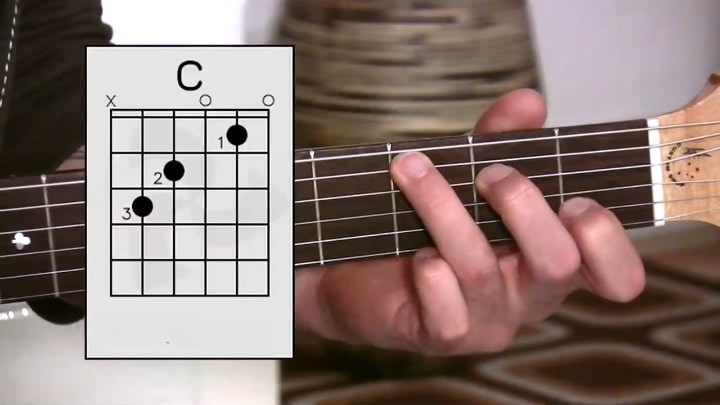
C Major is comprised of three-finger notes: C, D, and E.
- First, place your pointer finger on the 1st fret of the 2nd string.
- Next, place your middle finger on the 2nd fret of the 4th string.
- Lastly, place your ring finger on the 3rd fret of the 5th string.
- Strum each string except for the 6th string.
It is quite a natural shape for your fingers to form so it shouldn’t be too difficult to practice as a beginner.
3. D Major
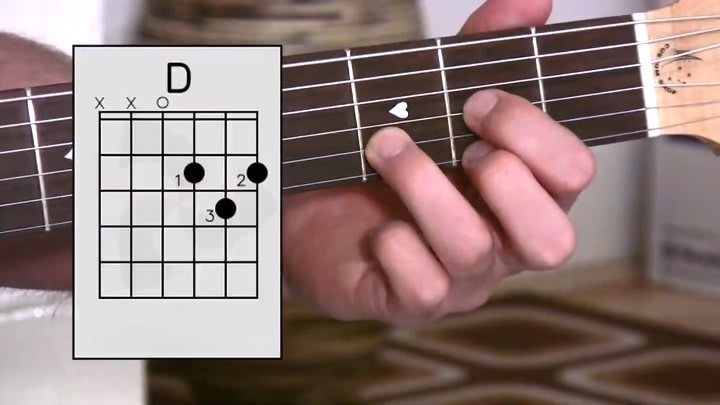
D Major consists of three-finger notes: D, F Sharp, and A.
- To begin, place your pointer finger on the 2nd fret of the 3rd string.
- Next, place your ring finger on the 3rd fret of the 2nd string.
- Lastly, place your middle finger on the 2nd fret of the 1st string.
- Strum each string except for the low E and A.
Ask any guitarist what the first chords to learn on guitar are? They will probably say D, C, and G major.
Once you know the G, C, and D major, you should go back and forth between the three to develop your muscle memory.
These beginner guitar chords are the first few chords you learn as a beginner because they are both conceptually and physically simple to execute.
4. A Major
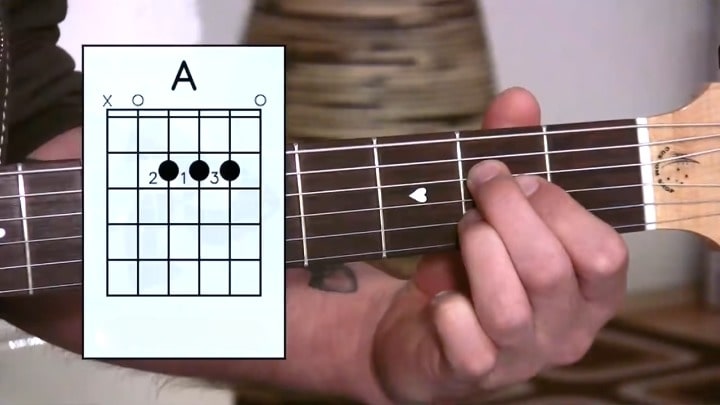
A Major consists of three-finger notes: E, A, and C sharp.
- This is one of the most basic guitar chords because each pressed note is located on the 2nd fret. There is no major stretching required.
- It’s an easy chord to play regardless of the size of your hand or the ability of your fingers to contort.
- Place your pointer finger on the 2nd fret of the 4th string.
- Next, place your middle finger on the 2nd fret of the 3rd string.
- Lastly, place your ring finger on the 2nd fret of the 2nd string.
- Strum each string except for the 6th string. Keep strumming until you hear a full and satisfying sound. It is important to strum all the way through.
Adding the A major to your bank of musical knowledge is a great way to start for a beginner.
5. A Minor
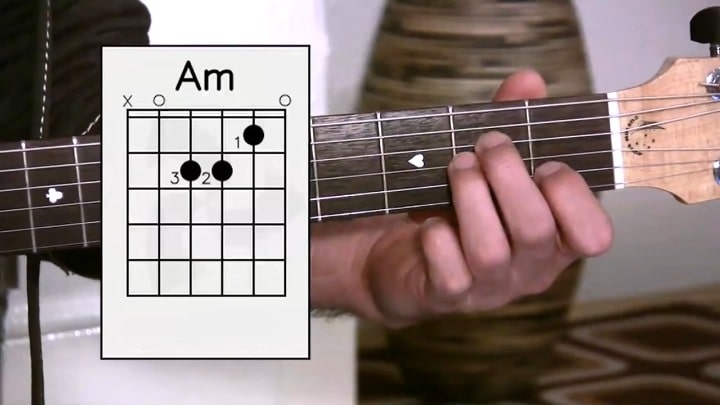
A, C, and D are three-finger notes in A Minor.
- Start by placing your pointer finger on the second string’s first fret.
- Then, put your middle finger on the fourth string’s second fret.
- Finally, put your ring finger on the third string’s second fret.
- Strumming all strings but the low E.
Learning the distinctions between a minor and a major by switching back and forth between them is an excellent idea. As a guitarist, you will need to understand this fundamental idea.
To enjoy practicing and improving later on, it’s critical to recognize early differences when learning guitar chords.
6. E Major
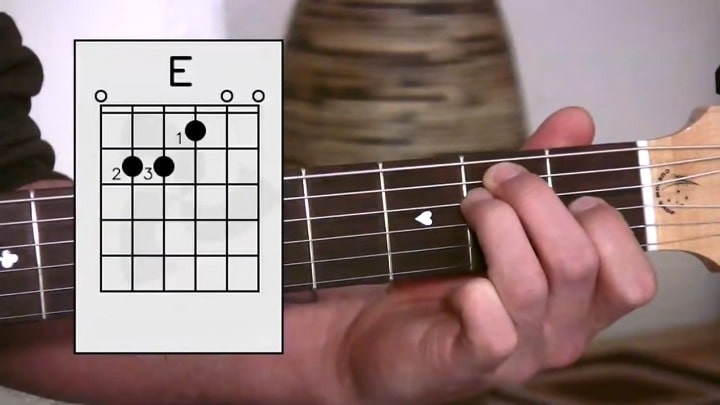
E, B, and G Sharp are the three notes that make up E Major.
- Put your index finger on the third string’s first fret.
- Put your middle finger on the second fret of the fifth string after that.
- Put your ring finger on the second fret of the fourth string at this point.
With this chord, strumming each string. E major will be a prominent chord in many well-known tunes, just like the other fundamental chords.
To make it more difficult to gain a good feel for the middle of the fretboard, try switching between the A and E chords. It can be challenging to tangle your fingers at times.
Nonetheless, it’s crucial to properly study guitar chords like E major. As a musician and guitarist, you’ll need to develop the proper finger placement and fretboard mechanics early on in your musical career.
7. E Minor
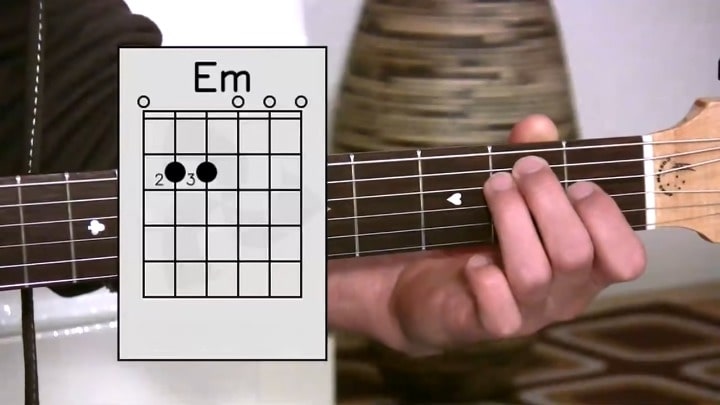
E and B are two-finger notes that make up the key of E Minor.
- Put your middle finger on the second fret of the fifth string to begin.
- Then, put your ring finger on the fourth string’s second fret.
That’s it. The entire chord is that.
This straightforward guitar chord will strum all the strings. Another simple chord will create a whole new world of opportunities.
Although you can master all of these chords in a single practice session, it will take you a few hours to really memorize them using a barre chord.
8. F Major
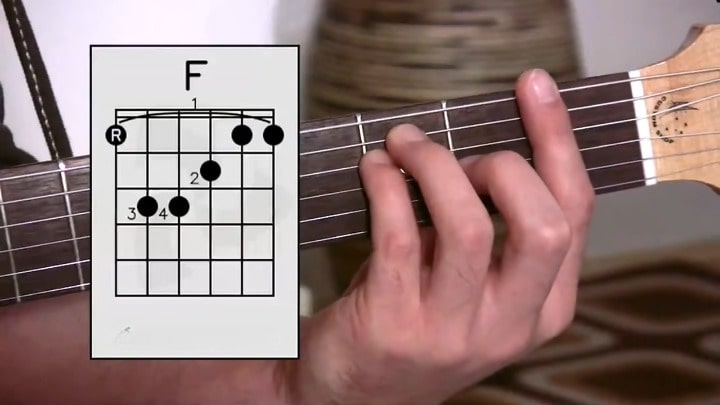
Although somewhat difficult for beginners, the chord in F Major is essential for improving your skills. A barre chord is what this chord is known as. On a single fret of the root note, the pointer finger is placed over all the strings.
This chord can be shifted to each fret, producing a new chord with the same name as the root note.
- Five finger notes make up the key of F Major: F, C, A, F, C, and F.
- With F Major, each finger is employed.
- Each string’s first fret is where the pointer finger is positioned.
- Next, put your ring finger on the 5th string’s third fret.
- Then, put your pinky on the fourth string’s third fret.
- Put your middle finger on the second fret of the third string at the end.
- With this chord, strumming each string.
With barre chords, your middle finger plays a crucial role. The chord is major when it is pressed on the fretboard. If you lift this finger, the chord then becomes minor.
This is probably the most awkward chord to play as a beginner. Unlike the previous seven chords, F major is a barre chord and requires more practice to truly master.
As a beginner, the shape of the F major may feel unnatural. If you practice, the chord will begin to feel comfortable, and you will be strumming to your heart’s content.
Once you learn these basic guitar chords, you will indeed become more confident in your guitar abilities.
Also, you will lay the groundwork for your potential as a songwriter. The guitar and the 8 fundamental guitar chords we’ve just talked about were used to write many excellent tunes. So go outside and start having fun!
9. B Major
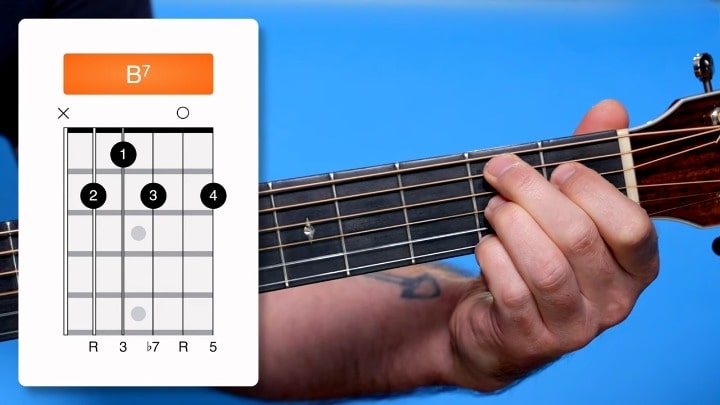
Similar to F Major, B Major is challenging for beginners but one that should be learned nonetheless.
It’s a well-known chord that appears in many songs, thus novices must learn it.
Beginners should become familiar with it as soon as possible. If your fingers are not accustomed to playing the F and B major and minor chords, you will find it difficult to play tunes.
The guitar chords and finger positions are rather straightforward. A barre chord is in B Major. As shown in the image above, your fingers is placed over the second fret. Moreover, you put your fingers on the fourth frets of the third, fourth, and fifth strings.
B Major might be the last major chord in the scale you want to master if you want to learn the fundamental guitar chords!
Nonetheless, it is a crucial chord shape to master because it can be utilized to create fantastic chords all throughout the fretboard. Barre chords will start to feel natural and fulfilling as you get past the awkward starting stage.
Although there are different ways to voice a B major chord, it is crucial to start with the fundamentals. There are many different methods to play chords, so as your skills advance, you can experiment with them.
You will start to feel like a real guitarist once you have learned the fundamentals of finger placement for guitar chords.
Then you can move on to chord progressions, arpeggios, and other complex musical ideas. There is no exclusive or absolute way to learn the guitar, so it is exciting when you start.
There are so many possibilities!
10. B Minor
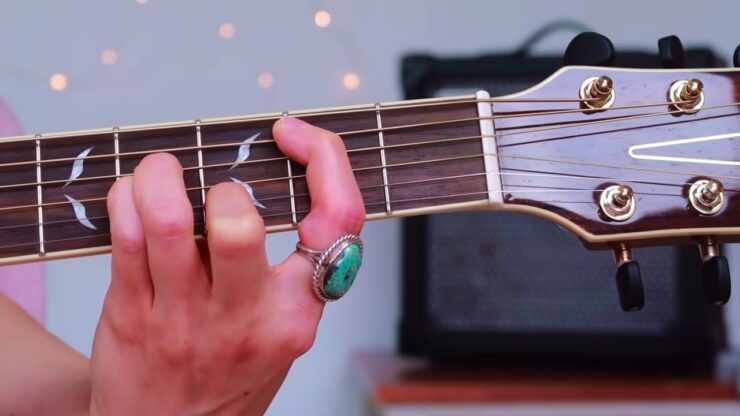
Similar to its sibling B Major, B Minor requires some difficult finger placement for newcomers. It is important to learn this chord early on because it is well-known and not very conceptually complex.
- You need all of your fingers, just like with the major.
- Your middle finger goes on the B string at the third fret.
- You barre the second fret, and your other fingers go on the D and G strings at the fourth fret.
To master this, practice might be necessary. It could still take some time to go from the B minor chords to others and vice versa even after you have learned the finger positioning. Yet, a newbie must learn it, and it is crucial that they do.
With this chord, strumming each string. As we’ve already mentioned, getting your middle finger in place is crucial for playing barre chords. You must get it correctly since the middle finger can transform a major to a minor. To obtain a complete and precise sound, you might need to apply more pressure than you might anticipate.
As it’s a barre chord, it will be challenging for a beginner to play it smoothly. As with all guitar chords, practice makes perfect!
You can experiment and practice for hours once you have mastered these fundamental guitar chords. These chord voicings, harmonies, and shapes are crucial, therefore you should devote a lot of time to learning them correctly.
Prior to starting your training with genre-specific material, it’s imperative that you comprehend these fundamental chords.
11. F Sharp Major
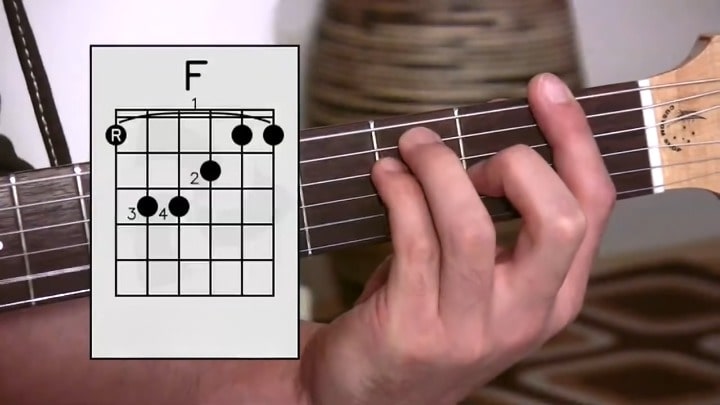
After learning a few minor chords, it is time to examine flats and sharps. Happily, you’ll be able to use the principles and finger technique you already know.
F Sharp Major is a barre chord, just like the other F chords. You must use your first finger to create a barre, as seen above.
It’s a crucial chord for beginners to learn, but there aren’t many straightforward voicings for it. Focus on mastering the simpler barre chords, such as F major and B major, before experimenting with flats and sharps.
At first, the finger positioning could feel strange. Your technique will advance with practice, and you’ll be able to switch between chords with ease.
A frequent chord in jazz, pop, and rock music is F sharp major. You should master this chord since it will let you to play your favorite songs and advance your knowledge of music theory.
12. B Flat Major

One of the most crucial guitar chords for beginners to learn is B Flat Major.
In addition, B flat major is the pitch used for instruments including the clarinet, trumpet, and tenor saxophone. This indicates that compositions for big band or concert band frequently use the B flat major scale.
By placing your other three fingers on the D, G, and B strings of the third fret, you can create the chord by barre-picking your index finger over the first fret.
Even for beginners, the finger placement should be comfortable. It’s simple to recall and not particularly awkward to play the cluster formation on the third fret.
Because it is one of the most common guitar chords and doesn’t require particularly dexterous fingers, it is the perfect barre chord for beginners to learn.
You can learn one of the crucial instrumental guitar chords if you want to play in an orchestra or a big band in B flat major.
13. C Sharp Major
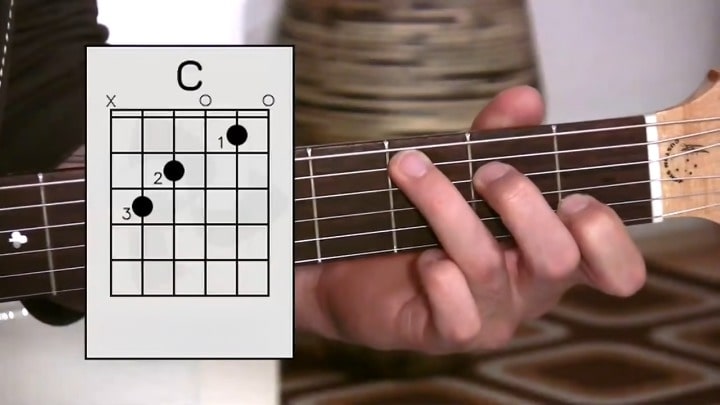
The C sharp major chord is encountered as we move deeper down the fretboard. Another very simple shape to construct for novices is this one.
You can want to press down harder and carefully examine your finger placement if the chord sounds odd or awful. Make sure you strum all the way through the strings and give them a full opportunity to ring.
This is one of the most often utilized guitar chords, just like the other major sharp chords. It is especially useful if you want to learn any popular songs or if you want to transpose songs into flat/sharp keys.
14. E Flat Major
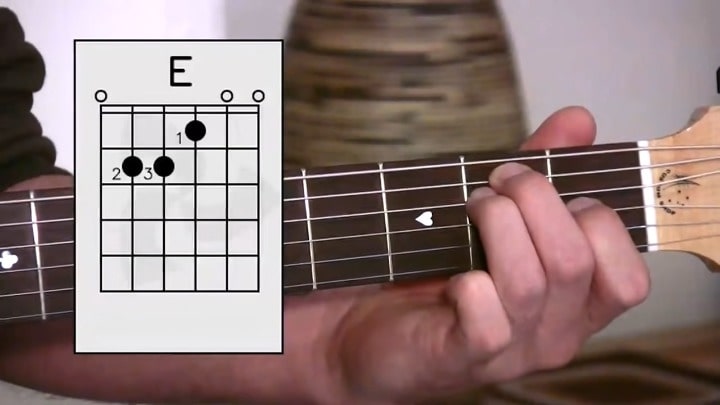
This chord requires a bit of stretching. For beginners, the E flat major is uncomfortable. It is clear that the hand position is not natural.
It is one of the most crucial guitar chords to learn, nevertheless. The E flat major is used in a lot of tunes.
Stretching your fingers and honing this E flat major will eventually be necessary if you want to play some of your favorite songs.
The G and low E strings are the only ones that the index finger can play for this chord variant. It will take some practice to master this delicate fingerwork.
FAQs
What chords should I learn first?
As a beginner, there are a few basic chords that you should focus on learning first. These chords are essential building blocks for many popular songs and will help you develop the foundational skills needed to play the guitar. Here are some of the chords you should learn first:
- A major
- D major
- E major
- G major
- C major
These chords are all relatively easy to play and can be practiced in a variety of different ways to help you develop your skills. Once you have mastered these basic chords, you can begin to explore more complex chords and techniques.
In addition to these chords, it’s also important to learn how to transition smoothly between chords. You can practice this by playing simple chord progressions, such as G-C-D or A-D-E, and focusing on changing chords quickly and smoothly. With regular practice, you’ll be able to play more complex songs and progressions in no time.
Can I learn guitar in 7 days?
While it’s possible to learn some basic guitar skills in 7 days, becoming proficient at the guitar requires a lot more time and practice. Learning any instrument takes dedication and a lot of effort, and the guitar is no exception.
In just 7 days, you could learn a few basic chords and some simple songs. However, it takes months and even years of practice to become proficient at playing the guitar. There are many techniques, fingerings, scales, and rhythms to learn, and it takes time to build up the muscle memory and coordination necessary to play them smoothly.
To improve your guitar playing skills, you will need to practice consistently, and it’s essential to have a good understanding of music theory, such as chords, scales, and rhythm. With consistent effort and regular practice, you can eventually become proficient at playing the guitar, but it’s unlikely to happen in just 7 days.
How many hours should I study guitar a day?
The amount of time you should study guitar per day depends on several factors, including your goals, schedule, and level of experience. However, it’s generally recommended to practice at least 30 minutes to an hour per day if you’re a beginner. As you become more experienced, you may want to increase your practice time to 2-3 hours per day or more.
It’s important to note that practicing guitar for an extended period without taking breaks can lead to physical strain and injury. Therefore, it’s recommended to take regular breaks during your practice sessions and to vary the types of exercises you do to avoid repetitive strain injuries.
Ultimately, the key to becoming proficient at the guitar is consistency and regular practice. Even if you can only practice for a short amount of time each day, practicing consistently will help you improve your skills and make progress over time.
Which is harder to learn piano or guitar?
According to many experts, the piano is harder to learn than the guitar. This is because the piano requires the use of both hands and a greater range of motion than the guitar. Additionally, the piano has a more complex and larger range of notes than the guitar, making it more difficult to master.
Many female guitarists have a problem making all chords right because they have smaller hands.
What is the hardest guitar chord?
The difficulty of guitar chords can vary depending on the individual player’s skill level and experience. However, there are some chords that are generally considered to be more challenging than others due to their complex fingerings or stretches. Here are a few examples of some of the hardest guitar chords to play:
- F#m7b5: This chord is a variation of F#m and involves playing a barre across the second fret with the second, third, and fourth fingers in different positions.
- B7#9: This chord is a variation of B7 and involves playing a barre across the second fret with the second, third, and fourth fingers in different positions.
- G#7b13: This chord involves playing a barre across the fourth fret and stretching the fourth finger to the seventh fret.
- C#maj7#5: This chord involves playing a barre across the fourth fret and stretching the third finger to the sixth fret while the fourth finger plays on the fifth fret.
It’s important to note that while these chords may be challenging, they are not impossible to play. With practice and dedication, even the most difficult chords can be mastered over time.
What is the devil’s chord on the guitar?
The “devil’s chord” is a nickname sometimes given to the tritone, which is a musical interval that spans three whole tones or six half-steps. On the guitar, the tritone is often played as a power chord with the root note and the flattened fifth note of the scale.
The tritone has historically been associated with dissonance and tension in music and has been used in various musical genres to create a sense of unease or darkness. It’s sometimes referred to as the “devil’s interval” or the “diabolus in musica” because of its dissonant sound and association with evil or demonic themes in music.
Conclusion
Learning how to play guitar is a lifelong endeavor. If some of these guitar chords appear a little perplexing, don’t give up. Make sure you master the ability to read chord charts quickly.
Maintaining consistency and practicing hand placement will eventually result in muscle memory. Everyone must begin somewhere. Have fun!
If you like this article read more here about the apps that can help you learn to play!
